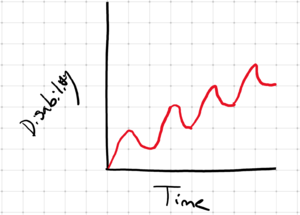Multiple Sclerosis (MS) Case Study: Difference between revisions
Adrian Smith (talk | contribs) No edit summary |
Adrian Smith (talk | contribs) No edit summary |
||
| Line 1: | Line 1: | ||
== Case Study Assignment == | == Case Study Assignment == | ||
* In progress, please do not edit prior to May 22, 2020* | * In progress, please do not edit prior to May 22, 2020* | ||
The purpose of the present fictional case study is to demonstrate major multiple sclerosis (MS) clinical findings and propose appropriate, evidence-based management interventions that effectively address an active patient’s participation restriction. | The purpose of the present fictional case study is to demonstrate major multiple sclerosis (MS) clinical findings and propose appropriate, evidence-based management interventions that effectively address an active patient’s participation restriction. | ||
| Line 25: | Line 25: | ||
!... | !... | ||
!85% of individuals | !85% of individuals | ||
! | !Test Table | ||
|- | |- | ||
|'''SPMS''' | |'''SPMS''' | ||
| Line 42: | Line 42: | ||
| | | | ||
|} | |} | ||
[[File:Physiopedia sample.png|alt=|left|thumb|300x300px|Table 1]] | |||
In the introduction, you give your readers an idea on the background of the case. Then discuss relevant cases and similar literature briefly. However, the most important aim of the introduction is driving your readers' attention to the purpose of your report. They should have a clear vision of your objectives | In the introduction, you give your readers an idea on the background of the case. Then discuss relevant cases and similar literature briefly. However, the most important aim of the introduction is driving your readers' attention to the purpose of your report. They should have a clear vision of your objectives | ||
| Line 49: | Line 49: | ||
Betty, a 29 year-old graphic designer first noticed her symptoms in the summer of 2019 when she was biking along the lake with her husband and noticed she was seeing two stop signs and had difficulty keeping her bike steady. As she finished her route she felt excessively fatigued. These symptoms persisted for a few days, eventually affecting her productivity at work, prompting a visit to her family physician. Upon assessment of MRI findings which showed demyelination plaques in the corpus callosum, the physician classified her event as a “clinically isolated syndrome” of MS. | Betty, a 29 year-old graphic designer first noticed her symptoms in the summer of 2019 when she was biking along the lake with her husband and noticed she was seeing two stop signs and had difficulty keeping her bike steady. As she finished her route she felt excessively fatigued. These symptoms persisted for a few days, eventually affecting her productivity at work, prompting a visit to her family physician. Upon assessment of MRI findings which showed demyelination plaques in the corpus callosum, the physician classified her event as a “clinically isolated syndrome” of MS. | ||
== Abstract == | |||
==Abstract== | |||
Complete Last | Complete Last | ||
Revision as of 23:00, 13 May 2020
Case Study Assignment[edit | edit source]
* In progress, please do not edit prior to May 22, 2020*
The purpose of the present fictional case study is to demonstrate major multiple sclerosis (MS) clinical findings and propose appropriate, evidence-based management interventions that effectively address an active patient’s participation restriction.
Patient Profile[edit | edit source]
Gender: Female Occupation: Graphic Designer Subtype: MS (relapsing-remitting) Dx currently?
Referral: Recent Dx from family physician, referred to PT to aid in functional goals related to hiking/something else?
Problem List:
- Fatigue (mental & physical)
- Deteriorating dexterity (typing, things falling out of hand)
- Psychosocial aspects of life affected (inability to participate in bike rides with husband, fatigue affecting ability to work full days? And some job tasks affected)
Introduction[edit | edit source]
MS Sub- Types
| RRMS | ... | 85% of individuals | Test Table |
|---|---|---|---|
| SPMS | |||
| PPMS | |||
| PRMS |
In the introduction, you give your readers an idea on the background of the case. Then discuss relevant cases and similar literature briefly. However, the most important aim of the introduction is driving your readers' attention to the purpose of your report. They should have a clear vision of your objectives
If there is anything interesting or challenging you met when Dx the patient or managing the case it's worth mentioning in the intro.
Betty, a 29 year-old graphic designer first noticed her symptoms in the summer of 2019 when she was biking along the lake with her husband and noticed she was seeing two stop signs and had difficulty keeping her bike steady. As she finished her route she felt excessively fatigued. These symptoms persisted for a few days, eventually affecting her productivity at work, prompting a visit to her family physician. Upon assessment of MRI findings which showed demyelination plaques in the corpus callosum, the physician classified her event as a “clinically isolated syndrome” of MS.
Abstract[edit | edit source]
Complete Last
Introduction[edit | edit source]
Client characteristics[edit | edit source]
Examination findings[edit | edit source]
Clinical impression[edit | edit source]
Intervention[edit | edit source]
Fatigue: Naps, moderate aerobic exercises, cooling Dexterity: Psychosocial:
Outcome[edit | edit source]
Discussion[edit | edit source]
Self study questions[edit | edit source]
References [1]
Any and all images follow copyright regulations outlined by Physiopedia [2]







